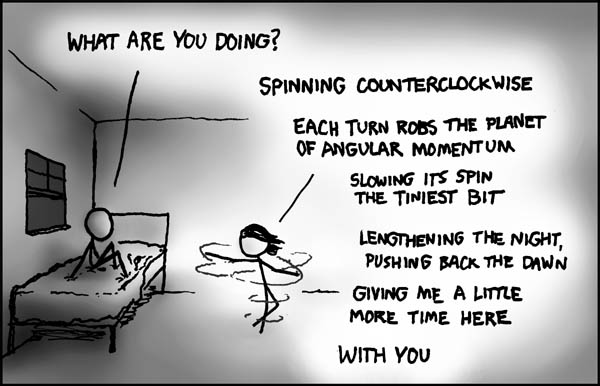 |
| Randall Munroe, you truly are a geek god. |
I got a great question from a reader named Sandy. After seeing the xkcd comic titled "Angular Momentum", Sandy wondered:
"...would [it] be possible to work out an estimate of how many people spinning anti-clockwise it would take to counteract the Earth's spin, assuming that the premise is sound."
Great question! First off, the premise is absolutely sound. Anyone who's watched a figure skater speed up when she pulls her legs in has observed angular momentum being conserved. Angular momentum conservation is fancy physics speak for "the universe likes to keep the total amount of spin-y things constant." In this example, as soon as people start spinning, the Earth's rotation will slow down, because the total amount of spin-y things has to be the same.
Admittedly, "spin-y things" is not the most descriptive term, so it helps to have a more formal definition. It's more difficult to stop an object from spinning when the object is (1) massive and (2) rotating fast. For this reason, you'd expect the angular momentum of a spinning object to depend on its mass and velocity. You might also expect it to depend on (3) how the mass is distributed throughout the body, since it's easier to spin a broom stick along its axis (i.e. drill-bit style) than it is to spin it perpendicular to its axis (i.e. helicopter style). These elements are combined to give an equation for the angular momentum,1
angular momentum = (mass) · (velocity) · (distance from mass to rotation axis).
A 150 lb. person spinning around once per second would have an angular momentum of about 100 kg·m2/s. The angular momentum of the Earth is roughly 7×1033 kg·m2/s, so it would take about 7×1031 people to counteract the Earth's spin. That's 1022 times the actual population, or enough people to cover the surface of the Earth 10 quadrillion times.
I should point out that even if you stopped the Earth's rotation in this way, it would begin spinning again as soon as everyone stopped rotating, because, as stated earlier, the universe likes to keep the total amount of spin-y things constant.2
[1] I should note that this equation works for point masses rotating around an axis. If you want the angular momentum for a something that's bigger than a single point, you need to add up a bunch of point masses. For a spinning person, you could add up the angular momentum of each atom to get the total angular momentum. In this problem, I've assumed the average atom in a spinning person is a 1 ft away from the axis of rotation and moving at 5 m/s.
[2] If my childhood experience with spinning carnival rides is any indication, I would not want to be around for the ensuing vomit parade that would inevitably follow this worldwide venture.
